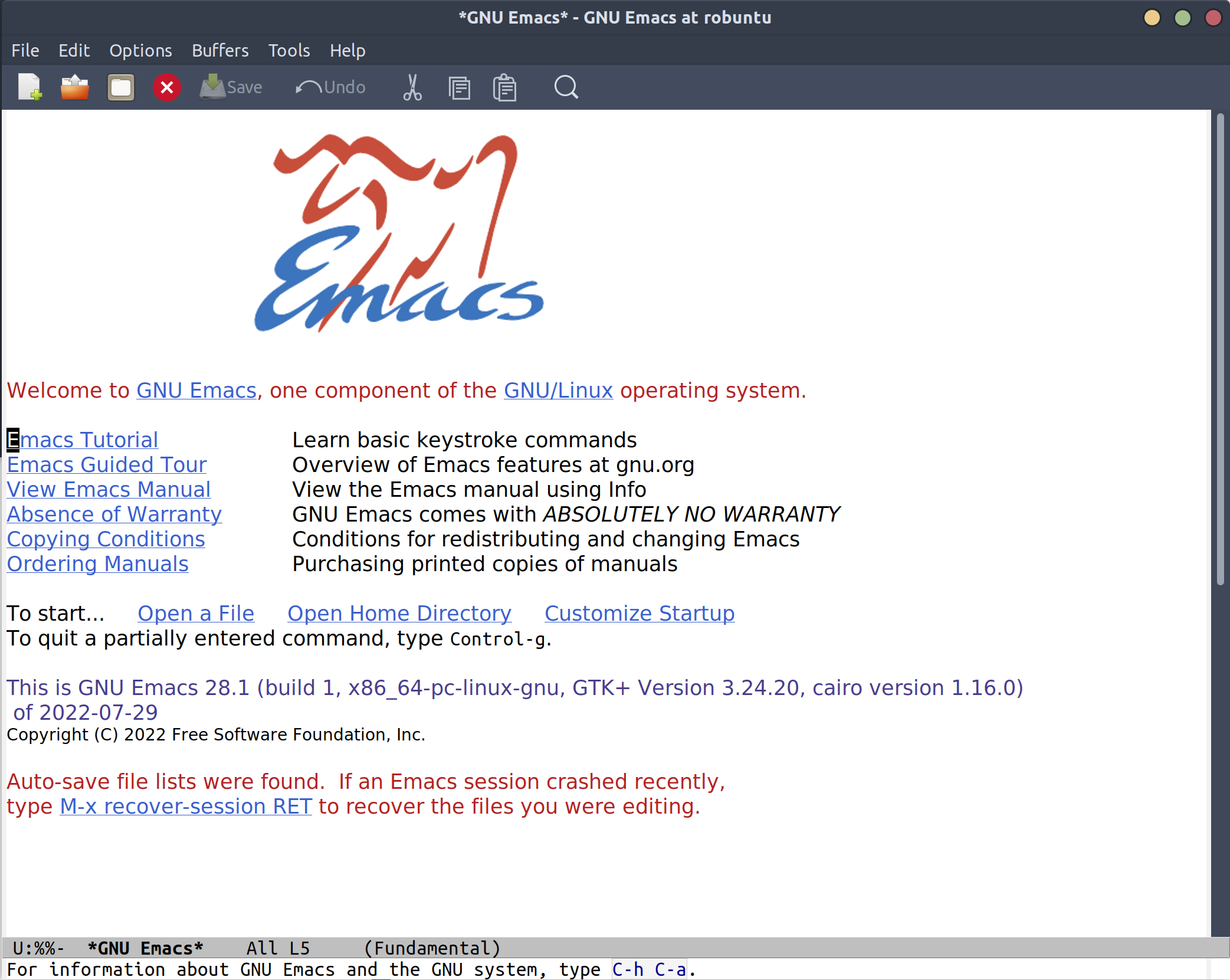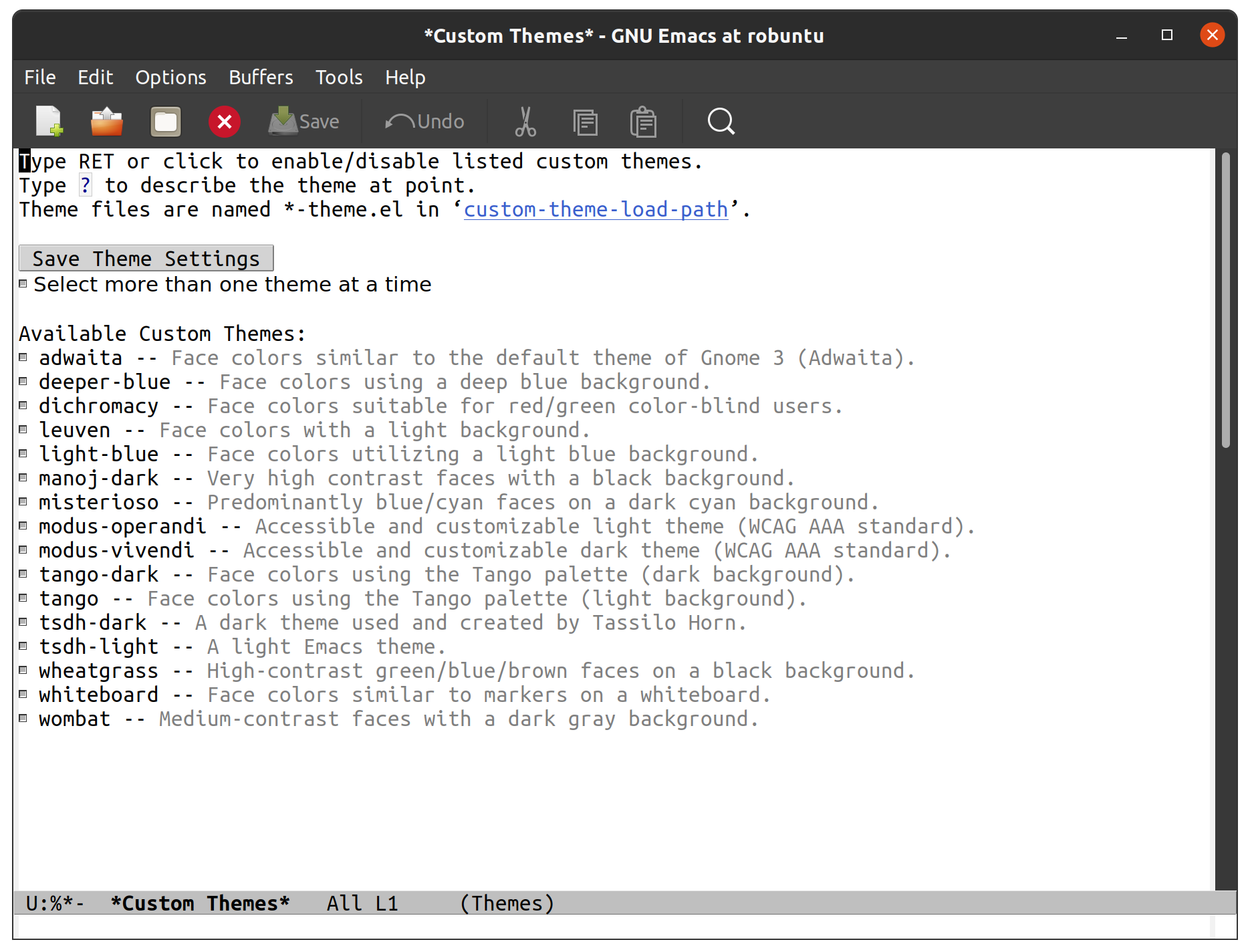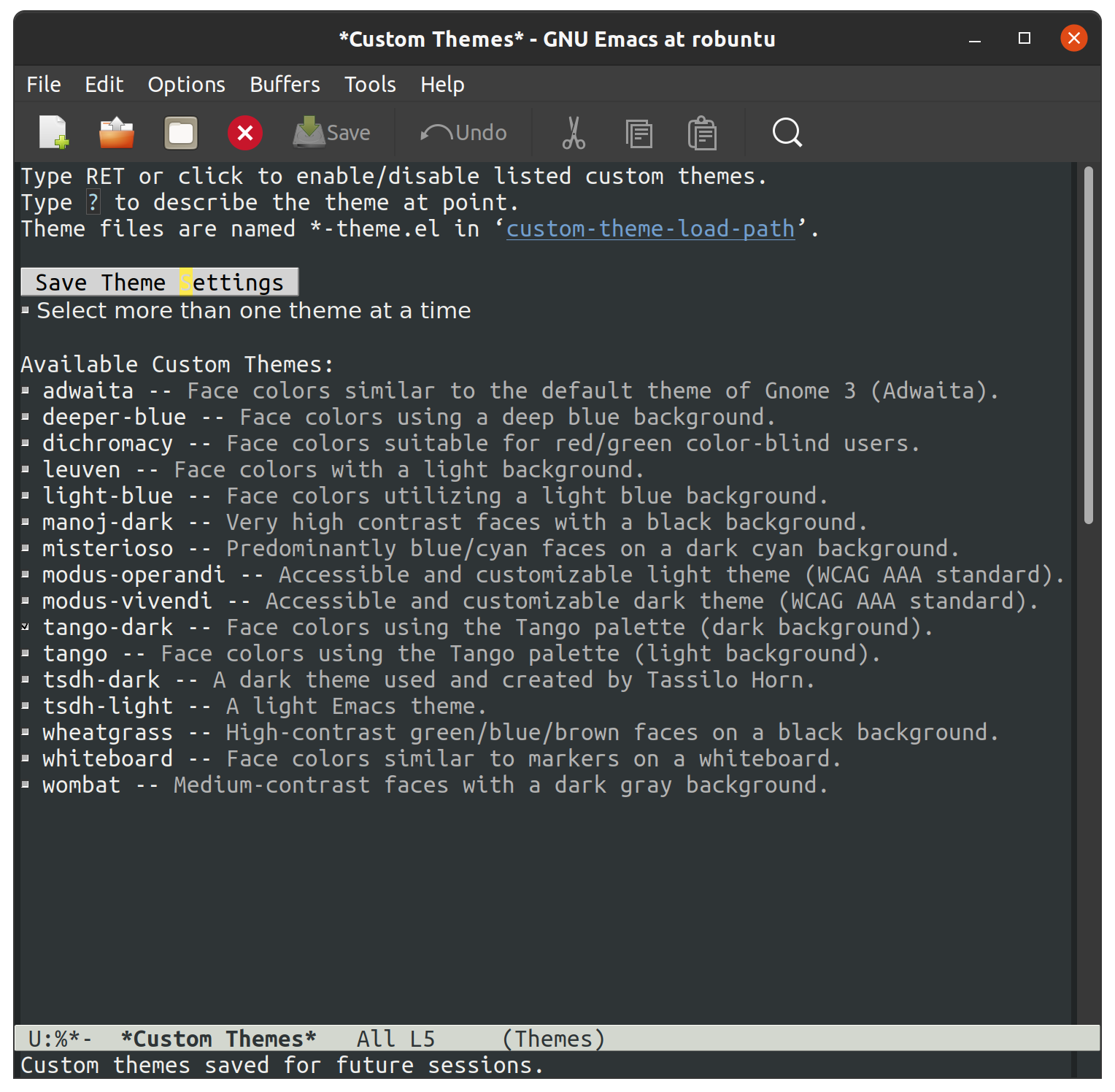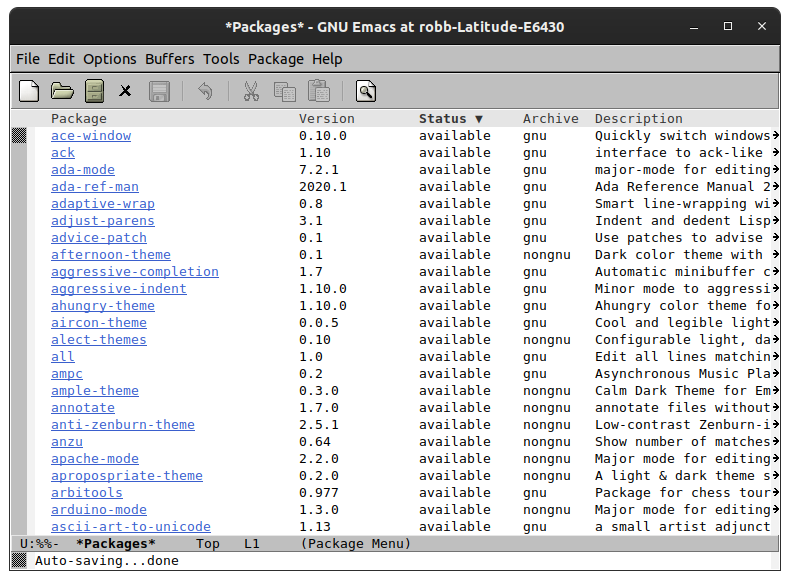Emacs Part 1: The Keyboard and Packages
Philosophy
This is the first part of a series in building an emacs configuration
around the data science toolkit, which I introduced in another
article. I won't be covering the absolute basics here, like how to
download and install Emacs, but just my thoughts as I start building
my configuration from a brand new
~/.emacs.d/init.el1. In many ways, this is a
notes-as-I-go type of article, and I may gloss over details I don't
find important yet or would become obvious after a little Googling.
If this is your first exposure to Emacs, this is what it looks like when you download it and start it without configuring it at all:

At this point, the world is your oyster - they provide a few helpful links to get a new user started, but basically we can take this program and make it do whatever we want, including writing and building this website! While Emacs is a fairly feature-rich editor by itself, I know there are features it doesn't provide off the shelf that I want to include, especially:
- Language server stuff - like pyright for Python editing
- A git management UI
- Intellisense-like code completion
That means we need to get comfortable with whatever plugin or package system emacs supports. My first impression exploring Reddit, package author sites, and github is that most Emacs-ers have an incredibly favorable view of throwing whatever kitchen sink you like into your configuration, as long as you feel happy.
This is a strikingly different attitude compared to (especially vanilla) Vim configuration advice. Typically when asking for advice in the Vim circles you'll first be greeted with "you aught to try this built-in capability first". There are also notably vocal members who will argue against using any plugin that doesn't serve some critical missing functionality of the editor. When dipping into the Emacs forums, quite to the contrary, I've seen members mention "I know person A does it like X because of Y, but I do W because Z", often from a place of understanding or empathy to a particular use case. One user even mentioned that they need vertical popup to assist with voice-powered coding tools, and hence will only consider auto-complete frameworks that work in that way for them. That level of community acceptance and support is encouraging to see, and Neovim has adopted a similar attitude to some extent, but is still somewhat nascent, especially with the recent Vim9/Lua debacle.
A brief note about keyboard shortcuts and finger contortion
I'm including this section about "how to use your fingers" because it's something I desparately wish had been laid out for me when I was first starting Emacs. There are a lot of key combinations in Emacs that rely on consistent, easy access to the Ctrl and Alt (option on macOS) keys. What I was lacking was a guide along the lines of "use your left little finger for this modifier, followed by your thumb for this one." Starting out, some of the combinations looked impossibly slow to be useful, just because of the muscle memory I already built around using Ctrl and Alt. For instance, imagine seeing this keyboard shortcut for navigating up three lines in Emacs:
- Ctrl + 3
- Ctrl + p
At the time, I was used to hitting Ctrl+3 with my right little finger
on the Ctrl in the lower right and left middle finger on the "3", and
then using the left Ctrl for Ctrl+p. That seemed like a lot of wasted
arm movement just to do what would normally be 3k in Vim. In
reality, nearly every Emacs user has the "Ctrl" key just to the left
of their little finger on the home row.2 This is where most
American keyboards place the "Caps Lock" key, which in my opinion is
just dead useless. Regardless of whether you use something like Vim
or Emacs, this is a good key to remap, and I do it on every
workstation with one of these pieces of software:
- macOS: Karabiner Elements (Third party)
- Windows: PowerToys (included with Windows 10)
- Linux: On Ubuntu/Gnome it's usually as easy as Tweaks -> Keyboard & Mouse -> Additional Layout options
- QMK Firmware - when I'm on one of my fancy programmable keyboards
Given that remapping, the combination should work like this:
- Left little finger holds down "Ctrl," using what is normally the "Caps Lock" key
- Press "3" with left middle finger
- Press "p" with right ring finger
- Release "Ctrl"
I can perform this version just as fast as 3k in Vim - since the
"Ctrl" and "3" can happen at the same time. Below I've listed my
general "finger flow" to maintain tempo while using Emacs. For the
rest of the article I'm going to use Emacs-style notation, which means
C-x is "Ctrl" plus "x" at the same time, and M-x for "Alt" plus
"x" at the same time. The M is short for "Meta", a vestigial
artifact of Emacs' history as a screen terminal program, and a
common point of befuddlement for young, unwary travelers like me.
- Left little finger for "Ctrl", left of "a" on American QWERTY keyboard in almost all cases
- Left thumb on "Meta" (Alt/option), just to the left of the spacebar for most cases
- Left little finger to use "Cmd" (Windows key, emacs calls this
"super") just to the left of "Meta", when modifying a right-hand
letter, i.e.
⌘-p - Either right little finger or right thumb to use "Cmd" when I need a
left-hand modified character, like
⌘-w, depending on the keyboard I'm using - For
C-xandC-cspecifically, I have my right enter key bound to "Ctrl" on hold, "Enter" on tap, so that I can type thexandccharacters as I normally would, without stretching my left little finger upwards and to the left at the same time. When I don't have the ability to program my Enter key this way, I'll hop between using the right Ctrl and modified Caps Lock key - For
M-x(that's "Alt" and "x" together, or "option" + "x" on a mac, which Emacs calls "Meta") specifically, I will usually use either my right thumb or right little finger on the Alt/option key, depending on the keyboard and how wide the spacebar is, because I find that more comfortable than crossing over on my left hand to hit both keys. Similarly, I findM-q,M-w, andM-zall easier by using both hands
Actually setting up the config
Now that we've made it past the first hurdle of using the keyboard, we can actually open Emacs and start configuring it. The most radical departure from my experience in Vim/Neovim starts here, with the Easy Customize interactive system. Emacs leans heavily on its interactive components, backed by plain text and data - which was admittedly a pleasant discovery. VSCode rediscovered this type of system by providing an easy customization UI representing a swath of JSON configuration under the hood, which has proved immensely popular. By comparison, I would argue that the Emacs interface is downright hideous, but easier to grok.
By way of example, let's walk what it looks like to customize the
color theme just via interactive commands. First, we hit M-x,
Emacs' equivalent of the "Command Palette", if you're coming from
something like VSCode or Jupyter, and enter customize-theme to get a
menu that shows all the default color themes we could use. Another
option, barring the use of M-x, is to use the menu bar and mouse
just like we would in any other GUI program: "Options -> Customize
Emacs -> Custom Themes" takes us to the same place.

Clicking the check box next to "tango-dark" and then clicking the "Save Theme Settings" results in a modified color theme that looks like this:

There are now two new things in your home directory:
- A file called
.emacs - A directory called
.emacs.d/
Opening the former using "File -> Open File…" (which may require turning on a "Show Hidden Files" option, depending on your system) shows us this set of text:
(custom-set-variables
;; custom-set-variables was added by Custom.
;; If you edit it by hand, you could mess it up, so be careful.
;; Your init file should contain only one such instance.
;; If there is more than one, they won't work right.
'(custom-enabled-themes '(tango-dark)))
(custom-set-faces
;; custom-set-faces was added by Custom.
;; If you edit it by hand, you could mess it up, so be careful.
;; Your init file should contain only one such instance.
;; If there is more than one, they won't work right.
)The code here is Emacs LISP - a programming language in its own
right - and the main configuration language for the Emacs editor.
Coming from Vim, where the only method of configuration is by
manually editing your ~/.vimrc, this really blew my socks off. The
implication here is that we can use interactive menus, backed by a
proper programming language (not just JSON data), which can take
effect right next to my hand-tuned configuration, and I'm free to
modify it however I like later on. It is a bit cumbersome to have two
folders dedicated to configuration, though, so the first thing I do
here is "File -> Save As…" and write it to ~/.emacs.d/init.el,
then delete the ~/.emacs file. Emacs will automatically detect this
and load the correct file the next time we start it up.
A short foray into elisp
Usually, the first symbol inside parenthesis is a function, and the remaining symbols its arguments. So, coming from more traditional languages like Java, Python, C, etc., I tend to visualize it this way:
elisp version Kinda like
------------- ----------
(foo) foo()
(foo "bar") foo("bar")
(foo "bar" 2) foo("bar", 2)
I say "usually" because there are other constructs, such as special forms and macros, but I'm definitely not getting to those for a while. I also say "Kinda like" because I'm pretty sure an experienced elisp-er would look at what I've written and say "yeah, no", but as I'm just starting out this is a helpful mental thesaurus.
Redirect "custom" to separate the interactive stuff from our hand-edited parts
We're going to do a combination of letting the customization menus manage the blocks like we showed above and writing a little configuration ourselves, so I'm going to redirect custom to a different file, then load it from there:
;; ~/.emacs.d/init.el
;; Redirect custom so it doesn't edit this file
(setq custom-file "~/.emacs.d/custom.el")
;; Load the custom file
(when (file-exists-p custom-file)
(load custom-file))In ~/.emacs.d/custom.el, I placed all the contents of what was
written by "custom" - the block that originally went to ~/.emacs
after saving the custom theme. Now we have two distinct spots for
customizing emacs:
~/.emacs.d/custom.el- managed by the interactive customization menus. We never touch this one by hand~/.emacs.d/init.el- customization we do write by hand
Later on I'll cover some other common settings for the init.el file,
but for now we'll leave it be to address more important things.
Namely, let's start plugging in new packages.
Edit what packages we use interactively
Unlike most package managers in the Vim world, it's rare nowadays to
grab code directly off github or submoduling/unzipping some tarball
into your configuration directory. Rather, there's a central
repository called ELPA, located at http://elpa.gnu.org/, which
hosts well-known packages we can install right away (Python folks can
think of ELPA a bit like PyPI). By running M-x list-packages, we're
prompted with this lovely screen:

There are a few special key commands, the most common of which I am
using are /n to filter by name and /s installed to look for
packages I currently have installed.
The first thing I wanted was a vertical pop-up style for my minibuffer
when using M-x or C-x C-f (finding files), a lot like the "command
palette" you get in other editors like VSCode, Jupyter, and JetBrains,
when selecting generic actions to take. As of Emacs 28, there's a built-in
vertical FIDO mode that mostly does this, but I kept getting a delay between
pressing M-x and the minibuffer popping up, so I opted for a third party
package called vertico that I'm very happy with. To install it, all I had
to do was use the M-x list-packages buffer posted above and click on "install",
or use M-x package-install RET vertico (that's M-x package-install, followed
by hitting "enter", then typing vertico and hitting enter again), and Emacs
has automatically done three things for me:
- Fetched the latest version of the package from ELPA and downloaded it
- Byte-compiled and installed the package into my editor
- Edited ~/.emacs.d/custom.el to signal that I selected and installed a new package
That last one is mind-blowing. Emacs edited a variable called
package-selected-packages and put it into my custom.el file, just
by the very nature of installing it interactively.
;; ~/.emacs.d/custom.el
;; --snip--
'(package-selected-packages
'(vertico))
;; --snip--This means I can use all of Emacs' interactive features, even while
keeping my configuration under the proper text-based version control
of my choosing. It also leaves the possibility of managing this
variable manually via ~/.emacs.d/init.el open, but we aren't there
yet. At any point, I can also use M-x package-delete or the
packages buffer to interactively remove a package from Emacs and
~/.emacs.d/custom.el. Since I'd like
to ship my Emacs configuration to many workstations, I'd like Emacs
to automatically install these selected plugins, and remove obsolete ones,
at boot. There are a couple functions that allow me to do this:
;; ~/.emacs.d/init.el
;; Enable built-in package manager
(require 'package)
;; Redirect custom so it doesn't edit this file
(setq custom-file "~/.emacs.d/custom.el")
;; Load the custom file
(when (file-exists-p custom-file)
(load custom-file))
;; At this point, package-selected-packages has been set by loading the custom-file
;; Remove any packages that are installed, but aren't listed in package-selected-packages
(package-autoremove)
;; Keep our registry up-to-date
(package-refresh-contents)
;; Install selected packages
(package-install-selected-packages)As far as I'm concerned at the moment, this is all the package management I need! The built-in support is so good that I don't find myself wanting to reach towards an external package manager at all, like I would typically do in Neovim.3
Community packages
There is also a community-maintained, much larger selection of plugins
on something called "Milkypostman's Emacs Lisp Package Archive",
usually abbreviated to MELPA, which serves an almost identical role as
ELPA, but doesn't require going through the official GNU channels to
get your project hosted. As such, most projects on GitHub require you
to enable fetching packages from MELPA before installing. There are
two versions of MELPA - melpa.org/packages and the "stable"
melpa.org/packages. Both the MELPA setup instructions and community
discussion recommend against the use of MELPA-stable, so I'll be
sticking with the regular version:
;; ~/.emacs.d/init.el
;; --snip--
;; Keep our registry up-to-date
(add-to-list 'package-archives '("melpa" . "https://melpa.org/packages/") t)
(package-refresh-contents)
;; --snip--There's a decent amount of elisp witchcraft in the add-to-list
statement alone, but in essence
it just enables Emacs to "see" what's on the community MELPA archive
when we run M-x list-packages or M-x package-install. After
adding this and digging around /r/emacs and github, I have a minimal
set of packages that are enabling me to be productive without too much
configuration so far4
- corfu (intellisense-like autocomplete; plays well with
orderlessbelow) - exec-path-from-shell (macOS specific)
- go-mode
- magit (UI for git, I think basically everyone grabs this)
- marginalia (preview that works amazingly well with
vertico, shows me things like documentation and keybindings next to commands when I openM-x) - markdown-mode
- orderless (a "completion style" that's pretty nifty, once you get the hang of it)
- restart-emacs
- rust-mode
- tree-sitter (more intelligent code highlighting)
- tree-sitter-langs
- use-package (a configuration macro, see below)
- writeroom-mode (distraction-free writing, which I use for this blog)
I am also trying out both lsp-mode with lsp-pyright and eglot for language server stuff to see which one I like better, but haven't finalized it yet so we'll keep them in our back pocket for now. I tend to shy away from exceptionally large frameworks, so helm didn't look appealing at first glance. I'd rather pick exactly the pieces I want to include and get them working one-by-one.
Configuring packages we've installed
The one piece that confused me more than anything while starting out
is what the heck use-package actually is or does. Many users online
would refer to it as "their package manager", however it is
emphatically not a package manager, as the very first section of
their README notes. Because I had just been copying use-package
snippets from around the internet before I took a minute to read the
use-package documentation, it took me a while to figure out that
use-package is meant to be used in conjunction with a package
manager, which in our case is the built-in package.el. After
package.el installs a new package, it's likely there are ways to
tweak that package that suit our tastes, and that is what we ask
use-package to do for us.
Without diving into too much detail, it's easy to imagine how complex managing package start up, configuration, and order-of-operations could be:
- Did I make sure load this package after its prerequisites?
- How do enable keybindings only when this package is active?
- How can I delay loading this big, expensive package until I actually need it?
It bears mentioning that there are ways to have use-package
interface with package.el, but I'm going to hold off on those until
I feel like I need them. Here's an example of how I configure
tree-sitter to add spiffy highlighting everywhere I go, without
bogging down startup time of emacs:
(use-package tree-sitter
:init (global-tree-sitter-mode)
:hook (tree-sitter-after-on . tree-sitter-hl-mode)
:config
(use-package tree-sitter-hl)
(use-package tree-sitter-langs)
(use-package tree-sitter-debug)
(use-package tree-sitter-query))The README on the use-package GitHub page explains all the special
:<section> bits, but in essence this is a clean way of saying:
- Run
(global-tree-sitter-mode)on startup - Turn on
tree-sitter-hl-modewhenever we boot uptree-sitter - Configure
tree-sitterto also use four other useful packages
There are many, many capabilities bundled into use-package, and even
very minimal configurations will tend to include it, because of the
brevity it brings to advanced package configuration.
Updates
- 2022-08-19: Recommend against the MELPA-stable repository, after a bit of research
For our resident Microsoft Windows users - I'll be
using Unix-style paths, which means ~ is the home directory, like
C:\Users\Robb, and / as path separators. Fret not, as Emacs will
understand this style of pathing and the ~, even on Windows
It's also likely that its predecessor TECO from the 60's was
developed on a terminal on which the "Ctrl" key was located just to
the left of a
Such as packer.nvim (inspired by use-package)
or vim-plug
I'll use another article to cover specific, intersting configuration on a per-package basis